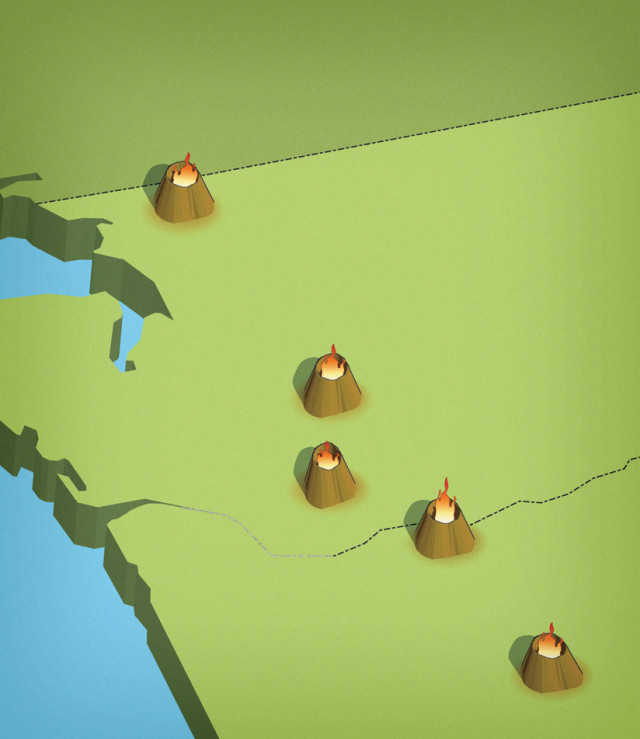Us vs. The Volcano

EVER SINCE MOUNT ST. HELENS blew its top 28 years ago this May, killing 57 people and covering 11 states with 540 million tons of ash, northwesterners have cast a wary eye at those jagged summits, wondering if the weekend’s forecast calls for lava bombs. Fortunately the U.S. Geological Survey’s Cascades Volcano Observatory in Vancouver, Washington, monitors the mountains using seismometers, satellite radar, and superaccurate GPS to pinpoint areas where the ground is moving. But eruptions can happen with little or no warning too. So we’re offering you this guide to five regional peaks to keep an eye on. Just in case.
MOUNT RAINIER
Last blast Around 1840, lava fragments were ejected from the summit cone but didn’t result in any carnage. If it blows Rainier’s plentiful ice and snow cover means an eruption could spell disaster for the resorts dotting its slopes and the cities farther downhill. Debris would slide down local river channels, three of which converge on the neighboring towns of Puyallup and Tacoma. Threat level The mountain hasn’t shown any recent seismic activity, so researchers don’t see any immediate threat. But that doesn’t mean your great-great-grandkids shouldn’t be a bit concerned.
MOUNT ST. HELENS
Last blast May 18, 1980—the deadliest and most costly eruption in U.S. history. Fifty-seven people killed in the blast, $1.1 billion in damage. If it blows It won’t be as devastating as ’80; the surrounding lodges and cabins destroyed in the blast were never replaced, and Route 504, the only major access road, has been rerouted to safer, higher ground. Threat level Since the mountain reawakened in September 2004, a series of smaller eruptions has created a new lava dome in the center of the crater—a sign that something could be brewing in the next few decades.
MOUNT BAKER
Last blast Some steam venting in the mid-nineteenth century. If it blows Debris flows, or lahars (basically thick stews of mud, rock, melted snow and ice, and anything else picked up along the way—nature’s own wet concrete), could storm down the Nooksack and Skagit Rivers to Puget Sound, wiping out the towns of Ferndale, Lynden, Mount Vernon, and Burlington en route. Threat level The only activity in the past 50 years consists of a few minor earthquakes and venting steam, but scientists don’t consider Baker to be dead—just slumbering.
MOUNT HOOD
Last blast In the 1790s; minor explosive activity in the nineteenth century. If it blows Kiss your Oregon ski vacation good-bye: Timberline, Meadows, and little towns like Zigzag and Rhododendron would be obliterated by avalanches and pyroclastic flows (currents of hot gas and rock that can exceed 50 miles per hour and temperatures of 1,000 degrees Fahrenheit). Deadly debris flows would reach Gresham and the Columbia River (via the Sandy River) in about three hours. Threat level While Hood has experienced a swarm of small earthquakes over the last three decades, volcanologists aren’t particularly concerned about the peak blowing its lid anytime soon.
THREE SISTERS
Last blast Possibly 50 BCE, although there have been minor seismic hiccups this century. If it blows Even a midsize debris flow of 50 million cubic meters—enough to fill 20,000 Olympic swimming pools—would bury the town of Sisters, Oregon, and all its quaint bed-and-breakfasts. Threat level Experts noticed changes in 2001, as an area about 10 miles in diameter rose by nearly a foot on one peak, thanks to magma building deep beneath the surface—a sign that the volcano could be priming for an eruption.




